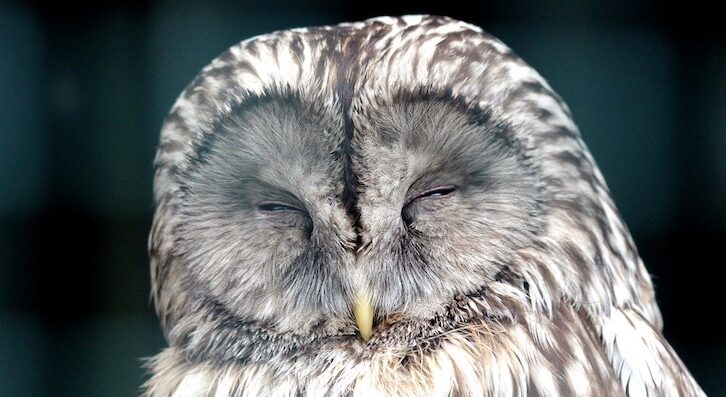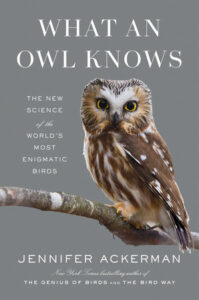
Why Harry Potter’s Hedwig Would Make a Terrible Pet
Jennifer Ackerman on the Complex Care and Keeping of Real Owls
Arguably the most famous pet owl of the twenty-first century, real or imagined, is Hedwig, Harry Potter’s Snowy Owl. Small wonder J.K. Rowling picked a Snowy for the starring role. The big white bird is the world’s most distinctive owl, with that gleaming white plumage.
In Rowling’s universe, Hedwig and other owls straddle the spheres of the magical and the Muggle as part of an owl post service, ferrying birthday greetings, packages, and even a Nimbus 2000, a wizard’s broomy vehicle, with efficiency and apparent ease. But they also serve as the wizards’ affectionate friends. When Harry needs it most, Hedwig provides warm, comforting companionship.
After the release of all seven of the Harry Potter books and the films based on them, Laura Erickson—a.k.a. “Professor McGonagowl”—made herself something of an expert on the owl appearances in the movies and even started a blog called The Owls of Harry Potter, inviting questions from readers.
Hedwig and other owls straddle the spheres of the magical and the Muggle.
In the films, Hedwig is female, Erickson told me. But the owls playing her were all male, and different males filled the role: Gizmo, Kasper, Oops, Swoops, Oh Oh, Elmo, and Bandit. Why male owls? “For one thing, females are bigger and heavier, harder for a young actor to handle, and they have powerful talons,” says Erickson. Daniel Radcliffe, who plays Harry in the films, wore a thick leather guard on his arm beneath his big black cloak. Talons that can nail a merganser through thick feathers can do a number on human limbs.
Also, she says, “the pure white plumage of older males compared to females looks more striking against a wizard’s black robes.” And why so many substitutes or stand-ins? Because apparently owl actors also need days off. Moreover, she says, owls are individuals “and as tricky to train as cats. One might be excellent at doing directed flybys, another might be much calmer sitting in a tiny cage on a movie set, and another better at interacting gently with a little boy while sitting on his arm.”
When one of her readers asked Erickson whether a Snowy Owl could really carry a Nimbus 2000, Erickson went to her neighborhood hardware store and weighed a corn broom—just over a pound, about half as heavy as a Snowshoe Hare, which Snowy Owls regularly carry to their chicks.
So yes, a real Snowy Owl could carry a Nimbus 2000. But the Snowy Owl in this scene simply flew through, and then the filmmakers digitally added the broom. The owls often dangle their legs when taking off or landing, says Erickson, so in this scene, the owl’s legs are already in position to be carrying something.
But J.K. Rowling made some elementary errors in her depiction of Snowy Owls. Unlike Hedwig, Snowies are mostly diurnal—although they also hunt in crepuscular hours. They don’t hoot as Hedwig hoots to comfort Harry or express her approval—their vocalizations are more like a bark. They don’t nibble on bacon rinds as Hedwig does when she delivers the mail at breakfast time. Perhaps most important, they do not make good pets.
“Don’t even think about taking an owl as a pet,” says Erickson. “They are wild birds requiring a wild life. In cages they simply cannot do all the things their bodies were designed for and their spirits require.” Moreover, they’re hard to care for. “They eat whole rodents or other whole animals, which must be fresh, and their droppings are messy and smelly, requiring frequent cleanup.” It’s a massive commitment, a way of life.
Like most licensed care providers for owls, Erickson will go on at length about the difficulties of keeping a real owl—and also the joys. Erickson is a former editor at the Cornell Lab of Ornithology and host of the radio program For the Birds. For seventeen years, she stewarded an Eastern Screech Owl named Archimedes (after Merlyn’s bird) and worked with him as an education ambassador, taking him to schools, bird groups, and symposia to teach people about the realities of being an owl.
Perhaps most important, owls do not make good pets.
A family had found Archimedes in their backyard on the ground beneath his nest, in very bad shape. “He was completely unfeathered,” Erickson says. “On one side of his tiny body, he had puncture wounds, and on the other side, he was all abraded and scabby.” It turned out the owl was suffering from a blood parasite, so he needed a lot of care. The family took him to a rehabilitation clinic, where he was nursed back to health. But because he ended up imprinting on humans, he couldn’t be released into the wild. He was later transferred to Erickson, who had a license to possess a screech owl for education. “That’s how I was lucky enough to get him,” she says.
Feeding Archimedes was a nighttime ritual. She would take a mouse out of the freezer at the start of The Daily Show, and by the end of The Colbert Report, it would be thawed, she says. “Sometimes he would bite it in half and just eat the head and upper torso, saving the back half to eat the next day. Sometimes he would eat the whole thing at one sitting, swallowing it headfirst and then letting it work its way down. You could watch how he would ratchet it, with the lower bill and the upper bill, and the tail would always be the last part to go down, like spaghetti.”
Each day, around six to eight hours after eating, he would spit out a pellet. To exercise him, she ran him around the neighborhood at night. She would put little jesses or straps around his legs, attach them to a leash, and start running. He would take off and fly right above her head.
Erickson considered her time with Archimedes a sacred privilege. When she was writing in her office late at night with the little owl in the room, she loved calling back and forth with him. Sometimes those exchanges lasted a half hour or more. “There’s a joke that we humans are never a cat’s owner—they see us as staff,” she writes. “I don’t think she writes. “I don’t think Archimedes saw me as staff, more like his mate.”
One August day in 2017, Erickson lost Archimedes. He seemed sort of sluggish that morning, she says. He called a little, but he didn’t seem his normal self. She went over to him and preened his face a couple of times, and he leaned into the preening, like he always did. She left the room for lunch, and when she returned, he had toppled off his perch onto the floor, dead.
“I like to imagine him free,” she wrote in a tribute to him, “flying under the moon or alighting on a massive limb of a big, old elm, or peeking out of a Pileated Woodpecker hole in an aspen, or whinnying under the stars somewhere out there in the universe. I like to imagine that he’s shaken off his obligation to teach people things they should already understand about the ways of owls and the value of nature—shaken it off the way he’d shake out his feathers after preening, a spray of feather dust forming a sparkling halo around him.”
__________________________________

From What an Owl Knows: The New Science of the World’s Most Enigmatic Birds by Jennifer Ackerman. Copyright © 2023. Reprinted by arrangement with Penguin Press, a member of Penguin Group (USA) LLC, A Penguin Random House Company.
Jennifer Ackerman
Jennifer Ackerman has been writing about science and nature for almost three decades. Her most recent book, What an Owl Knows: The New Science of the World’s Most Enigmatic Birds, explores recent findings on the biology, behavior, and conservation of owls. Her previous book, The Bird Way: A New Look at How Birds Talk, Work, Play, Parent, and Think, was a finalist for the PEN/E. O. Wilson Literary Science Writing Award. Her New York Times bestselling book, The Genius of Birds, has been translated into twenty-five languages and was named one of the best nonfiction books of 2016 by The Wall Street Journal, a Best Science Book by NPR’s Science Friday, and a Nature Book of the Year by The Sunday Times. Her other books include Birds by the Shore: Observing the Natural Life of the Atlantic Coast, Sex Sleep Eat Drink Dream: A Day in the Life of Your Body, and Chance in the House of Fate: A Natural History of Heredity. Ackerman’s articles and essays have appeared in National Geographic, The New York Times Magazine, Scientific American, and many other publications. She is the recipient of numerous awards and fellowships, including a National Endowment for the Arts Literature Fellowship in Nonfiction, a Bunting Fellowship, and a grant from the Alfred P. Sloan Foundation.



















